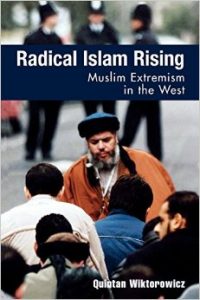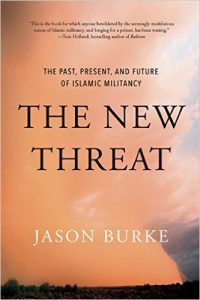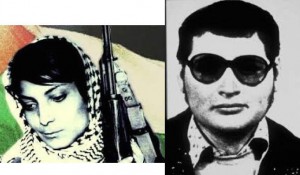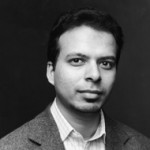What will we do if an Islamist regime, which grows dewy-eyed at the mere mention of paradise, ever acquires long-range nuclear weaponry? — Sam Harris, End of Faith, p. 129

Dr. Quintan Wiktorowicz takes a more nuanced view of what it takes to tip a person into a commitment to extremism. Wiktorowicz’s explanation might be worth noting as a counterbalance to Sam Harris’s fears since he is
- one of America’s leading academics on the Muslim World,
- an internationally recognized author and expert on national security engagement and counter-terrorism,
- a developer of ground breaking counter-radicalization initiatives for the Intelligence Community and the Department of State,
- a holder of two senior positions at the White House as driver of efforts to advance national security partnerships and innovation at home and abroad.
This post follows on from two earlier ones addressing Wiktorowicz’s findings:
- Islamic Radicals and Christian Cults: Cut from the Same Cloth
- How Minds Are Opened to Extremist Views
Recall that W’s case study is the now-banned British group, al-Muhajiroun. From Wikipedia:
Al-Muhajiroun (Arabic: المهاجرون; The Emigrants) is a banned Salafi jihadi terrorist organisation that was based in Britain and which has been linked to international terrorism, homophobia and antisemitism. The group operated in the United Kingdom from 14 January 1986 until the British Government announced an intended ban in August 2005. The group became notorious for its September 2002 conference, “The Magnificent 19”, praising the September 11, 2001 attacks. The group mutates periodically so as to evade the law; it then operates under aliases. It was proscribed under the UK Terrorism Act 2000 on 14 January 2010 together with four other organisations including Islam4UK, and again in 2014 as “Need4Khalifah”.
While reading Wiktorowicz’s study I was often struck by the similarities between such a political-religious extremist movement and what I know of cults in the “Christian world” — Jehovah’s Witnesses, Mormons, Branch Davidians, Wordwide Church of God, Moonies, and others. Of course there are many differences, too, but the patterns of what leads otherwise unsuspecting individuals to take an interest in “counter-cultural” groups and (seemingly bizarrely) leave the “normal” world to dedicate their lives to such “fanatics”.
In the previous post we saw what prompts persons to question their previously held beliefs and open themselves to radical alternatives, what factors lead some of those new inquirers take seriously and explore more deeply an extremist group and even to agree with its teachings.
We have also seen that people can take an interest in “fanatical” organisations, even sympathize with them and agree with their views, but never take the next step of actually joining them and living according to their dictates. That final step is taken by a still smaller subset. It means the person has decided to give up everything in “this life”, everything that most of us consider the fundamentals of a normal existence — possessions, family ties, perhaps even one’s own life.
“Religions may do more harm than good by telling people a life after death awaits them. In all probability, many terrorist attacks and other tragedies would not occur in the absence of that belief.” — HumanismByJoe.
However, serious research into the beliefs and lives of terrorist supporters reveals that common religious belief in an afterlife is far from sufficient to lead one to terrorist sympathies. Indeed, devout religiosity among Muslims correlates with rejection of terrorism. It is for most part the non-religious who are attracted to extremist movements. Their brand of religion is part of their “culturing” within the terrorist-sympathetic group.
What trips a person over that final line and into the extremist commitment?
Notice that Wiktorowicz finds that accepting beliefs or teachings of itself does not prompt people to give up “normal life” and be prepared to sacrifice all. Recall, further, that in the previous post Wiktorowicz even finds that Muslims in Britain who view themselves as quite devout are the least likely to be attracted to terrorist groups.
That final trip-wire is what Wiktorowicz labels “culturing”.
Even if religious seekers are exposed to al-Muhajiroun and accept Omar Bakri’s right to sacred authority, this alone is not enough to overcome the free rider dilemma. Seekers could attend lessons and learn about Islam without committing themselves to risky activism. In this manner, they could free-ride and reap the benefits of an Islamic education without incurring the costs and risks of commitment.
To understand why some individuals eventually commit themselves to the costs and risks outlined in chapter 1, we must understand movement “culturing,” or what activists term tarbiya (culturing in proper religious beliefs and behaviors). Al-Muhajiroun tries to draw seekers into religious lessons, where they can be cultured in the movement ideology. The ideology, in turn, emphasizes that the only way to achieve salvation and enter Paradise on Judgment Day is to follow the movement’s prescribed strategy, which includes high-risk activism.
Wiktorowicz, Quintan; Wiktorowicz, Quintan (2005-07-21). Radical Islam Rising: Muslim Extremism in the West (p. 167). Rowman & Littlefield Publishers. Kindle Edition.
So what is this “culturing” process and how does it lead people to self-sacrificing activism? Continue reading “Does growing “dewy-eyed at the mere mention of Paradise” lead to suicidal terrorism?”







